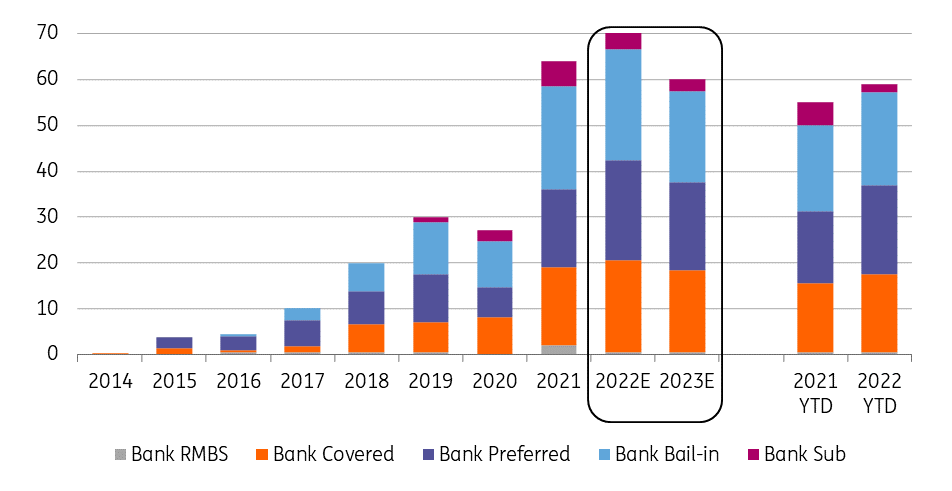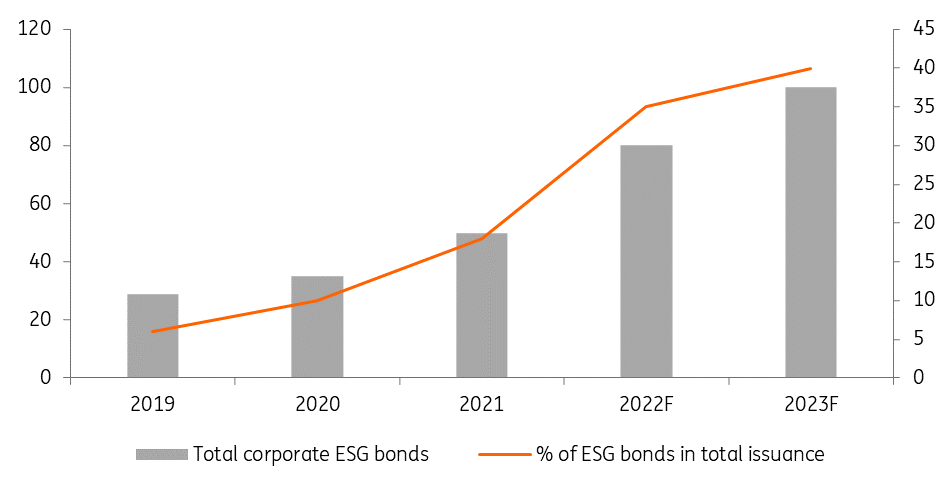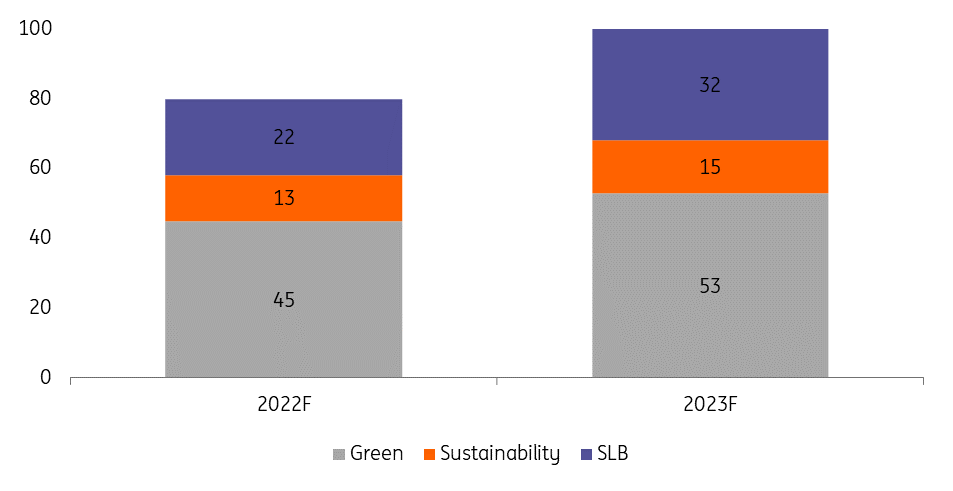Euro sustainable bond supply set to stagnate in 2023
Euro sustainable bond issuance in 2023 is not likely to repeat the growth rates seen in the last few years. While governments and agencies could slightly accelerate ESG issuance in 2023, financial institutions' ESG bond supply will lose some steam. Corporates are expected to remain active with sustainable bonds representing 40% of their total issuance
2022 sustainable bonds issued in the € currency will exceed 2021 but will end up short of our initial higher expectations. We forecast 2023 total Environmental, Social, and Governance (ESG) bond issuance to be stable compared with 2022 at €355bn. A strained geopolitical environment and tougher credit market conditions make bond issuance more pricey.
| €355bn |
total sustainable bond supply in 2023 in € credit markets |
Government and agencies' sustainable bond issuance to report moderate growth in 2023
After an issuance volume nearing €180bn this year we expect only very moderate growth next year towards €195bn. Sovereign issuers have seen all of the main issuers enter the market, and it is now smaller issuers such as Greece that are contemplating inaugural green bonds in 2023. That also means that an additional growth push out of that direction looks unlikely. For SSAs (Sub-sovereign organisations and agencies), the EU will continue to play a dominant role as the plans remain in place to raise 30% of the Next Generation EU fund via green bonds. The Next Generation EU fund, also called the Recovery Fund, may contribute up to €30bn to EUR SSA green bond issuance.
| €195bn |
expected sustainable € bonds by governments and agencies in 2023 |
SSA social issuance, which has made up around a quarter of the overall SSA ESG supply, is currently dominated by the two French agencies CADES and UNEDIC followed by the Dutch BNG and NEDWBK. The EU only issued slightly more than €2bn in social bonds under the SURE programme in 2022. We would expect that situation to persist in 2023, but would not exclude the off chance that the EU’s social issuance could see a revival amid a prolonged energy crisis and recessionary environment.
Sustainability linked issuance (SLB) continues to play a very niche role among sovereigns, seeing only dollar-denominated issues from two South American countries. In EUR the Dutch state treasury has indicated that such issuance could become part of the funding mix, yet not in the short term as they would have to be part of a political process.
Financial institutions' ESG bond issuance to lose some steam
The integration of environmental and social sustainability aspects into the business operations of banks has strongly accelerated in recent years. This has not only been driven by regulation but also by the wider societal sense of urgency to combat climate change and protect the environment.
ESG is a top priority for banks, including in their capital markets presence
Banks have become more vocal and transparent about their environmental and social strategies and targets. These not only comprise actions taken to reduce their own climate footprint, but also involve actively engaging with clients to support them in improving their environmental footprint, or distancing themselves from sectors deemed highly polluting, such as fossil fuels. They develop dedicated lending products at attractive terms, such as green mortgage loans, for the financing of environmentally sustainable projects or assets.
Green and/or social bonds have become increasingly popular as a source of funding for banks in recent years. In 2021, banks issued a record €64bn in euro sustainable bonds through different types of instruments, ranging from covered bonds to subordinated bonds. This was more than double the supply seen in previous years. Banks are well on their way to breaking this record in 2022.
Sustainable bank bond supply (in €bn)

During the first ten months of this year, banks issued €58bn in sustainable bonds, of which €17bn were in covered bonds, €19bn in preferred senior, €20bn in bail-in senior and €2bn in subordinated paper. This is up from €54bn over the same period last year. While green issuance is more than €10bn higher than last year, social and sustainability supply falls €7bn short of the first ten months of 2021. This largely reflects the lower refinancing of Covid-19-related small and medium-sized enterprises (SME) and/or healthcare loans through social bonds.
| €60bn |
New sustainable supply in € by banks in 2023 |
For 2023, we expect less issuance in sustainable bank bonds (€60bn) despite the high refinancing need of banks due to the targeted longer-term refinancing operation (TLTRO)-III expirations. The major reason is the anticipated slower lending growth. This will mitigate the ability of banks to naturally expand their green and social loan books. Meanwhile, the growth potential for supply via new sustainable bond issuers will at some point reach its limit.
That said, demand for sustainable investment alternatives will remain disproportionally high. This will incentivise banks to continue to look for possibilities to grow their green and social loan portfolios, including through the identification of new types of sustainable assets. Regulatory disclosure requirements, including those related to the EU Taxonomy, will support banks in the further identification of environmentally and/or socially sustainable assets on their balance sheet.
Sustainability-linked bonds (SLBs) are still shunned by banks
The issuance of sustainability-linked bonds is still not really taking off in the banking segment. Thus far only one bank printed a EUR sustainability-linked preferred senior unsecured note, with a reduction of the carbon intensity of the bank’s loan portfolio as a sustainability performance target. This contrasts sharply with the corporates segment, where nowadays about a third of the sustainable bond supply is in the SLB format. The proceeds of sustainability-linked bonds are used by issuers for general purposes, but the characteristics of the bond (such as the coupon) can vary depending on whether the issuer meets its predefined ESG performance targets. However, coupon step-up features may be seen as an incentive to redeem the bond early. This makes it difficult to issue senior unsecured or subordinated bonds in SLB format eligible for a bank’s minimum requirement for own funds and eligible liabilities (MREL).
Corporate issuers will remain very active on the sustainable bond markets
Corporate issuers and investors alike are embracing ESG as core financing or investment philosophies. As the pressure from societies, governments, activists and regulations accelerate, there is a bigger push for ESG issuance – particularly now with the European Central Bank favouring ESG debt for their reinvestments. This expected shift will only make ESG bonds more interesting to issue in the future.
| €100bn |
corporate ESG bonds in € currency in 2023 |
We forecast a total corporate € bond issuance around €270bn in 2023, up from c.€230bn in 2022. The percentage of ESG bond supply relative to overall € corporate supply is growing year on year. We expect this to jump up to 40% in 2023, up from 35% in 2022. We expect the industrial sector to lead issuance with c.€45bn of ESG bonds next year. Utilities could print up to €40bn of SDG bonds, representing between 75% and 80% of the sector’s total supply in 2023.
Total corporate ESG bonds (in €bn) and share in total issuance (%)

For corporates, green bonds will remain the dominant format
We believe that green bonds will remain the preferred format representing more than half of ESG corporate issuance, but we assume sustainability-linked bonds will continue their ascension with about €32bn issued out of the €100bn we forcast for next year. Social bonds have been absent from corporate issuance, except for one social bond issued by the French utility EDF in 2021.
Sustainability bond issuance by type (in €bn)

This publication has been prepared by ING solely for information purposes irrespective of a particular user's means, financial situation or investment objectives. The information does not constitute investment recommendation, and nor is it investment, legal or tax advice or an offer or solicitation to purchase or sell any financial instrument. Read more





